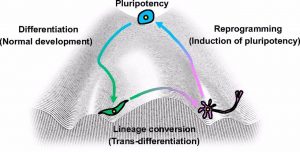Newsletter Signup - Under Article / In Page
"*" indicates required fields
British researchers have created a new type of stem cell in mice. It has even greater potential than current cell lines in research and in the clinic.
Stem cells have huge potential in research and therapeutics and overcome the limitations of current cell lines – embryonic and induced pluripotent stem cells. Findings published in Nature report that researchers at the Sanger Institute in Cambridge, UK have cultured cells from the earliest stages of development, which will provide researchers with a blank canvas. They believe that this could have a big impact on regenerative medicine and help us understand developmental disorders.
The cells have been named Expanded Potential Stem Cells (EPSCs). What distinguishes these new cells from embryonic cells is where they are found: embryonic stem cells are taken from the blastocysts, but EPSCs are from an earlier stage of development. The group has also found a way to reverse embryonic and induced pluripotent stem cells back up the developmental pathway.
After fertilization, the egg divides into 4 or 8 cells that retain some totipotency – the ability to produce all cell types in the body. These are EPSCs, and they are less developed than embryonic stem cells, which are taken from a ball of around 100 cells – the blastocyst. EPSCs were grown in special conditions to inhibit key signals and pathways in development.

Pentao Liu, project leader from the Wellcome Trust Sanger Institute, explained the big benefit of these new cells: “The earliest cell is like a blank piece of paper, in theory it should have the greatest development potential. The hope is that these cells could open up endless possibilities for researchers and clinicians.
This was meant to be the generation of regenerative medicine, but progress has been slower than hoped. Investors are warming to the idea of exploring stem cell technology as, for example, Fujifilm spent $307M (€260M) buying Cellular Dynamics. These findings could eventually help to refine the technology that biotechs are working on. For example, TiGenix‘s stem cell therapy for Crohn‘s disease and Celyad‘s heart failure treatment. Another use for stem cells is in conservation, where EPSCs could be used to support the breeding of endangered species.
Next, researchers will try to isolate these cells in humans. But, progress has been slow due to fears over tumor formation and difficulties faced creating mature cells. These problems must be resolved and will remain a problem regardless of the starting materials we have available to us.
Images – nobeastsofierce / shutterstock.com; Takahashi, K et al. (2013). Development. 140: 2457-2461.






